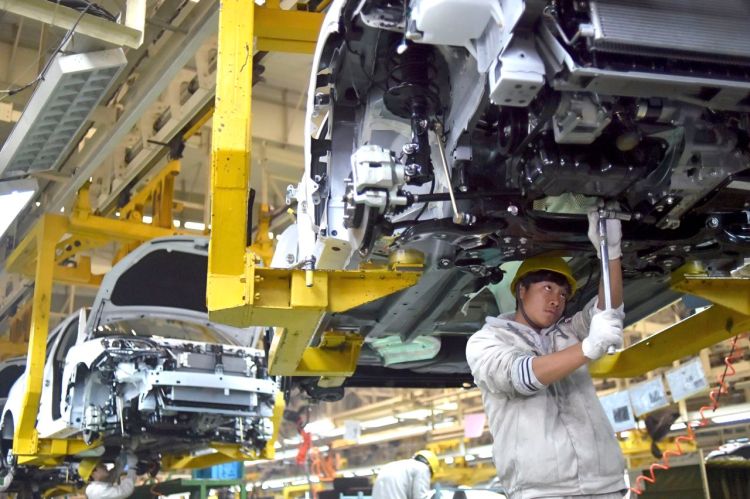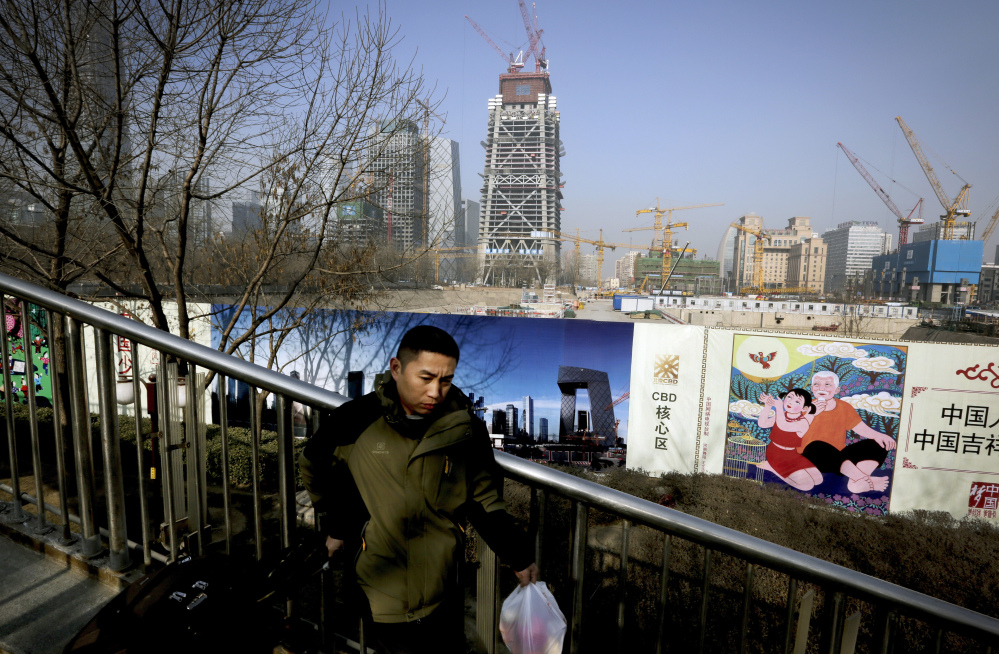BEIJING — The slowdown of China’s once-sizzling economy has fueled anxiety over its impact on the rest of the world. Yet when Beijing reported Tuesday that its economy grew last year at the slowest pace in a quarter-century, the reaction seemed to be mainly relief that it wasn’t worse.
Economists welcomed details in the report suggesting that the world’s second-biggest economy is making some progress in a difficult and complex transition – away from a reliance on manufacturing and investment in real estate and factories and toward dependence on services and consumer spending.
Stocks rose Tuesday in Asia and Europe, and the Dow Jones industrial average closed with a small gain.
“Things are OK,” said Fotios Raptis, senior economist at TD Economics. “There’s not an outright collapse going on in China.”
Beijing reported that economic growth fell in 2015 for a fifth straight year – to 6.9 percent, down from 7.3 percent in 2014 and the slowest rate since 1990. For the October-December quarter, growth inched down to 6.8 percent, the weakest quarterly expansion in six years.
The deceleration is at least partially deliberate as the ruling Communist Party aims to manage the economy’s transition to a structure that will almost certainly deliver slower growth.
Tuesday’s report contained signs of progress. Services businesses accounted for a record 50.5 percent of China’s economic activity last year, the first time its share has exceeded 50 percent. Services grew 8.3 percent last year, outpacing the traditional drivers of economic growth – manufacturing and construction – which together grew 6 percent.
Overall growth was in line with private-sector forecasts and the ruling Communist Party’s official target of about 7 percent for the year.
“Official data do not point to a hard landing in the fourth quarter of 2015, but they provide little reason to stop worrying about China’s drag on the global economy, either,” economist Bill Adams of PNC Financial Services Group said in a report.
Investors were relieved that more pessimistic forecasts about fourth-quarter growth were wrong, and expect Beijing to continue rolling out stimulus measures to prevent a hard landing.
Beijing has responded to ebbing growth by cutting interest rates six times since November 2014 and launching measures to help exporters and other industries. But economists note that China still relies on state-led construction spending and other investment.
Full-year 2015 growth was the lowest since sanctions imposed on Beijing after its crackdown on the Tiananmen Square pro-democracy movement caused growth to plummet to 3.8 percent in 1990.
The October-December growth figure was the slowest quarterly expansion since the global financial crisis, when growth slumped to 6.1 percent in the first quarter of 2009.
“The international situation remains complex,” Wang Bao’an, commissioner of the National Bureau of Statistics, said at a news conference. “Restructuring and upgrading are in an uphill stage. Comprehensively deepening reform is a daunting task.”
Growth in investment in factories, housing and other fixed assets, a key economic driver, weakened to 12 percent in 2015, down 2.9 percentage points from the previous year. Retail sales growth cooled to 10.6 percent from 2014’s 12 percent.
December exports shrank 1.4 percent from a year earlier, well below the ruling party’s target of 6 percent trade growth. For the full year, exports were down 7.6 percent, a blow to industries that employ millions of Chinese workers.
Forecasters see indications that retail sales and other activity accelerated toward the end of 2015, suggesting that Beijing’s efforts to put a floor under the downturn are gaining traction.
“The growth picture remains two-sided. The real estate construction slump and weak exports continued to weigh on activity,” Louis Kuijs of Oxford Economics said in a report.
“Meanwhile, though, consumption continued to expand robustly, supported by solid wage growth,” said Kuijs. “The robust growth in the consumption and services nexus is key for policymakers. They need it to avoid labor market stress.”
In June, global financial markets were rattled by a plunge in Chinese stock prices. Chinese stock markets have little to do with the rest of its state-dominated economy, but investors abroad took the decline as a sign the economy was weaker than thought.
A growing number of private-sector analysts question the reliability of China’s data, suggesting economic growth is much weaker than reported.
Julian Evans-Pritchard of Capital Economics said other measures of activity suggested economic growth in the latest quarter was 4.5 percent, though that still would be among the world’s strongest.
Spending on online commerce grew by 33.3 percent over 2014, an encouraging sign for official efforts to nurture a consumer economy. Wang said the share of total economic activity accounted for by consumption rose to 56.4 percent. That was up 5 percentage points from 2014.
Forecasters expect economic growth to decline further this year, with the International Monetary Fund targeting a 6.3 percent expansion.
Tuesday’s figures “fit the expectation of China watchers: The Chinese economy is slowing down, but only gradually,” said David Dollar, senior fellow at the Brookings Institution and former China hand at the U.S. Treasury Department and the World Bank.
Send questions/comments to the editors.




Success. Please wait for the page to reload. If the page does not reload within 5 seconds, please refresh the page.
Enter your email and password to access comments.
Hi, to comment on stories you must . This profile is in addition to your subscription and website login.
Already have a commenting profile? .
Invalid username/password.
Please check your email to confirm and complete your registration.
Only subscribers are eligible to post comments. Please subscribe or login first for digital access. Here’s why.
Use the form below to reset your password. When you've submitted your account email, we will send an email with a reset code.